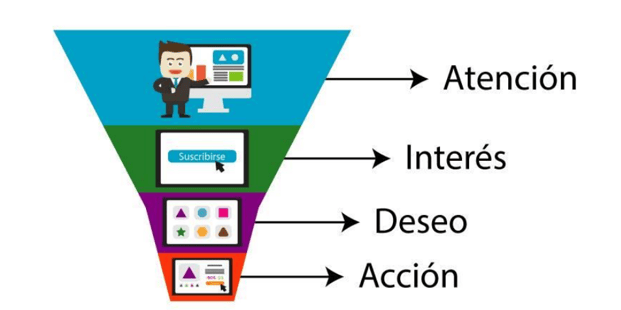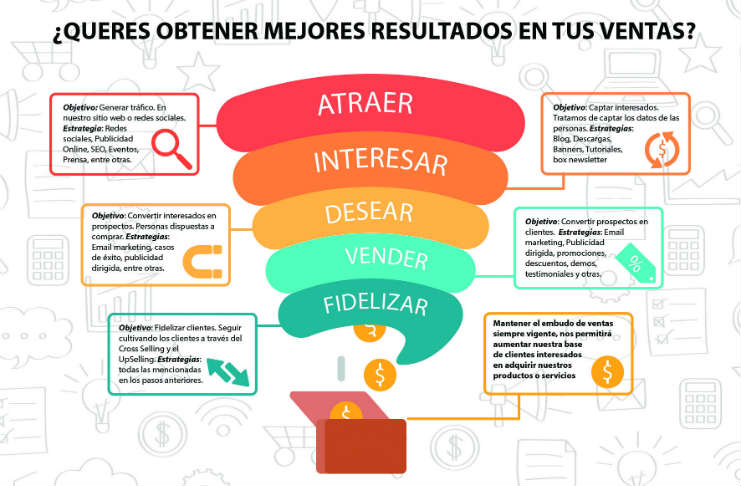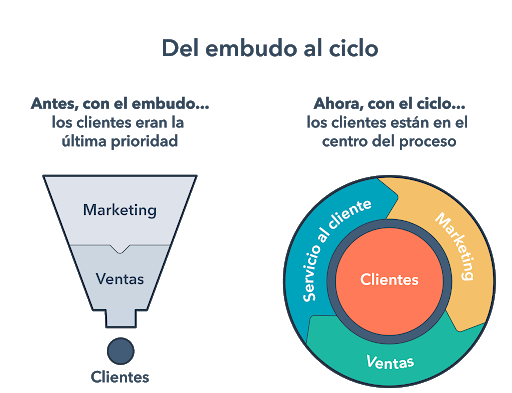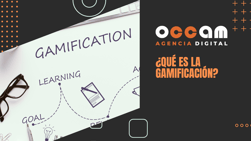Index Content
A sales funnel is a graphic model that describes the different stages that a user goes through from the moment they make contact with the company until they make a purchase. It is also called a conversion funnel or sales funnel, as the way to represent the path that the customer goes through is in the form of a funnel. The first stage is wider and larger than the last, where more customers are found, although the path narrows gradually as the depth of the relationship between customer and company progresses, as not all potential customers end up being convinced.

KATHERINE ELIZABETH YANEZ ROJAS
Origin of the concept
The sales funnel is an evolution of a previous marketing concept: AIDA (Attention, Interest, Desire and Action). The acronym represents the stages that a customer goes through, as does the sales funnel, from the moment he/she contacts the company until he/she makes a purchase or ends the relationship.
The transition from one model to the other is the result of an evolution in which technology has played an important role. Since 1989, when the American publicist Elias St.Elmo Lewis defined the AIDA method, new tools have been incorporated into the sales process that have fostered this change in terminology.
Through the sales funnel, the company plans processes to capture users who can eventually become leads, customers or even promoters. Although the sale is usually the main objective, it is not the only one.
Stages of the sales funnel
The study of customer behaviour in the brand discovery process has revealed that, as a general rule, there are four main stages that largely correspond to the previous AIDA model.
- Action or Contact
This is the first stage of the funnel, the widest and therefore the one in which most people meet. It is the moment in which a user establishes the first contact with the company. It is an action directed, above all, from the company towards the potential buyer. Through traditional marketing tools ranging from advertisements to newsletters, promotions and profiles on social networks.
An important part of this phase, if you want to achieve success in the sales funnel, is to correctly choose which customers to target with the acquisition tools. This has been one of the changes that marketing has undergone over time, assuming that it is not so efficient to attract the majority of potential customers, how to conduct a study of who may feel interest and need for the product offered and then make a strategy to find and attract them.
A fundamental requirement for moving on to the next stage of the funnel is that the person with whom you have established contact leaves their details so that you can continue in contact with them, i.e. that they make the process of converting into a lead .
- Interest, Prospect or Lead
At this stage, the company has lost some of its potential customers, those who have not wanted to leave their contact details, users who have not found what they were looking for or who have abandoned the process of researching their purchase. What can be known from this is that those who have reached this second stage have an interest in the company and/or in the product or service it offers.
The information that users have left at the end of the previous stage is fundamental in this one. It is analysed, classified and segmented in order to individualise the strategy for each one and thus optimise the sales funnel. An interaction has taken place that has generated a link with the company.
- Desire, Opportunity
In this phase, the leads that have previously shown their interest by providing their data, show it again by searching the web, going to the points of sale, responding to offers... They show attention and show an active attitude towards the company that evidences the interest that the leads have in purchasing a product. In other words, they show that it has not been a momentary interest but that they have truly gathered information and their research has convinced them to want to buy in a certain shop or shop.
This is the moment when the company detects this new opportunity, a new movement on the part of the customer, and relaunches its offers and marketing actions to try to completely convince the user and convert him/her into a customer.
- Action or Closing
This stage is reached if the actions carried out by the company are successful and the customer makes a purchase. Up to this point, the company may have had to interact with the customer on several occasions, and the customer may have gone back to the previous stage of the funnel on some occasions.
This is the stage where the funnel is the narrowest, because it is the last stage and where the fewest customers arrive. From the first contact to the purchase, many customers have been left behind in the process.
- Loyalty
Although the stages of the sales funnel are traditionally four, a fifth stage is usually considered as the end of this process. Loyalty is understood as a further relationship between the customer and the company that is due to the satisfaction of the former with the latter. The customer is satisfied with the purchase to the point that he/she becomes a regular customer and/or promoter of the latter.
It occupies a good place as the last stage of the funnel, moreover, because fewer customers become regulars or promoters, so the last place is graphically and metaphorically optimal to describe this last step.

Womeninbusiness.com
The sales funnel is not a fixed and invariable process. These four stages are general assumptions based on a large number of case studies and can be improved by focusing on some marketing strategies such as distribution channels.
Key elements in the sales funnel
To carry out a sales funnel, it is advisable to take into account some elements that play an important role to achieve success and to make the customer complete the whole journey.
- SMART objectives: Setting a final objective as the goal of the funnel is essential, but it must be coherent and well defined. By SMART objective we mean a Specific, Measurable, Achievable, Relevant and Time-bound goal.
- KPI Indicators: Performance Indicators: What data will be used to determine whether our strategy, for which we have decided to use a sales funnel, has been successful. Are we talking about an increase in the number of sales? It does not have to be just that. Suffice it to say that the KPI indicators are closely related to the pre-established objectives, as they are the indicators that show whether these previous goals have been achieved.
- Analysis of the data obtained, generating results. It is not enough to check that the customer has completed all the phases. An enriching element of the sales funnel is the complete analysis of the process. Do not only count who reached the end of the funnel, but also look at weaknesses.

Hubspot
Customers today have much more power in the buying process and self-manage the pace of sales with more autonomy and independence from salespeople than a few years ago.
Of course, the sales funnel is a common strategy among companies because of its benefits, including the definition of a sales methodology which, therefore, translates into an increase in the number of sales.




